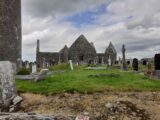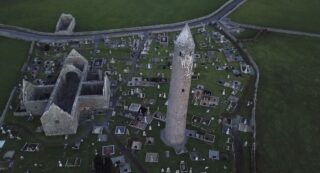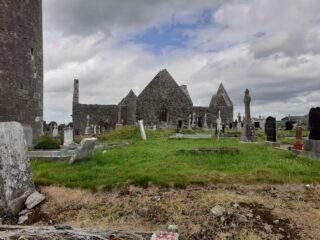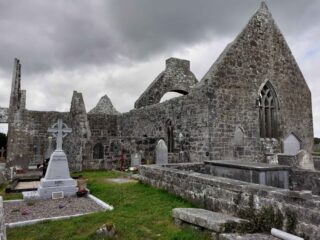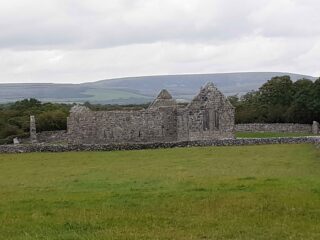Notice
Kilmacduagh Friary is a state-owned National Monument in the care of the Office of Public Works
WARNING: It should be noted that these sites are unguided and a level of care and caution should be maintained during all stages of your visit. The Office Of Public Works (OPW) will not be held responsible for any damages, injuries, or losses that occur
Kilmacduagh Augustinian Friary
Kilmacduagh Friary forms part of the monastic settlement of Kilmacduagh, see Kilmacduagh Monastic site. This friary, north of the monastic site, was under the patronage of the O’Heyne family who had the friary built for the Augustinian Canons in the early 12th The original monastery was founded on land belonging to Guaire, king of Uí Fiachrach Aidne, in the 6th/7th century. It is accepted that the founding saint was St Colman Mac Duach. The monastic site was important enough to become a new diocese, Diocese of Kilmacduagh, in the 12th century. The seven-storey leaning round tower, at the main monastic site just south, indicates that the monastery was financially thriving. This is demonstrated by the numerous attacks and raids the site suffered in the 12th and 13th centuries. Kilmacduagh witnessed the constant battle between uncle and nephew, Cathal Crobhdearg Ua Conchobair and Cathal Carragh Ua Conchobair at the turn of the 13th century. Both uncle and nephew were aided by the newly arrived Anglo-Norman knights. John de Courcy was on the side of Cathal Crobhdearg, while William de Burgh supported Cathal Carragh. None the less, the O’Heyne family held their lands at Kilmacduagh. After the dissolution of the monasteries, the entire monastic settlement was granted to Richard Burke, 2nd Earl of Clanricarde. In turn, Clanricarde leased the lands to various landlords. The building south-west of the friary may have been a domestic building associated with the nearby friary. It has a single-light round-headed window dating to the 15th century.
The cathedral, to the south, is a multi-period nave and chancel church. The west gable dates to the 11th century, the nave to the 13th, and transepts and chancel to the 15th century. The nave has a carved bishop’s head in stone; the transepts have high pointed arched and the sacristy has a round headed door. Windows come in numerous forms, including three-light tracery windows, flat-headed three-light windows, twin-light windows and an ogee-headed window.
A holy tree is also part of the complex. In 1927 it was described as an Ash tree that was held in great veneration. Also known as MacDuagh’ tree, it has also been described as a Yew tree. The tree was located to the west of the cathedral.
At Kilmacduagh, subsidiary churches were also built. The subsidiary church, Templebeg, 100m south-west of the cathedral is almost square in plan. The foundations and part of the north wall survive with modern day drystone walls and entrance. The other church, Templemurry, is rectangular in plan and dates to the 13th century. A limestone cross-slab, richly carved, is incorporated into the internal north wall.
Visit Historic Environment Viewer for more information on Kilmacduagh Friary
Protect our Past - Click here to read about the importance of protecting our country’s unique heritage sites
This national monument is protected in accordance with the National Monuments Acts 1930 to 2014
Gallery
Nearby sites to visit
Ennis Friary
Admire some exquisite Renaissance carvings
Approx. 23.3 km from Kilmacduagh Augustinian Friary
Athenry Castle
An emblem of Norman lordship
Approx. 29.6 km from Kilmacduagh Augustinian Friary
Portumna Castle and Gardens
Seventeenth-century splendour on the shores of Lough Derg
Approx. 44.8 km from Kilmacduagh Augustinian Friary
Aughnanure Castle
A historical gem in the heart of Connemara
Approx. 48.6 km from Kilmacduagh Augustinian Friary
Askeaton Castle
A ruined stronghold of the earls of Desmond
Approx. 50.1 km from Kilmacduagh Augustinian Friary
Adare Castle
Discover a medieval masterpiece, built for defence
Approx. 54.1 km from Kilmacduagh Augustinian Friary
